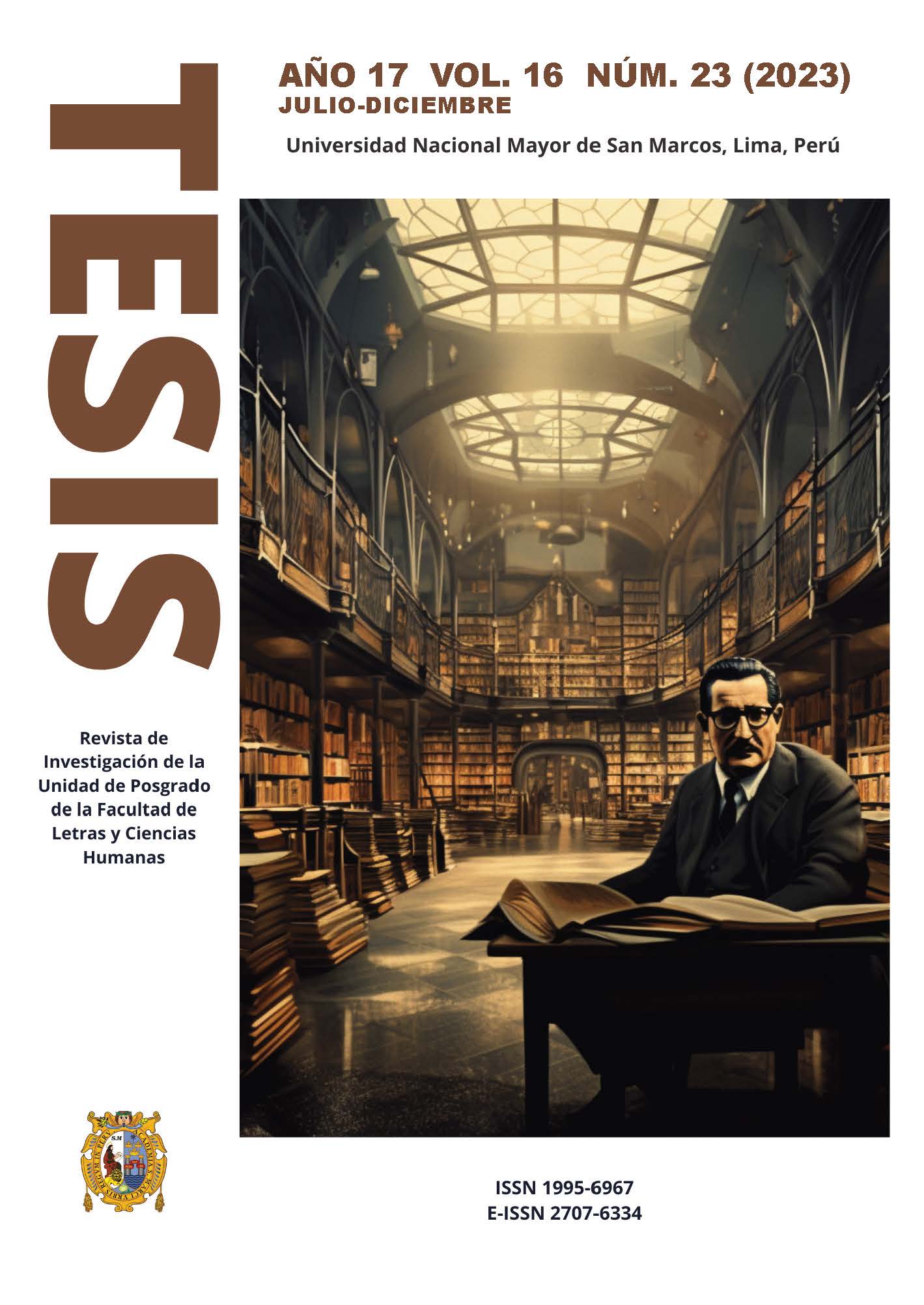“La mujer sin territorio”: un análisis sobre los roles de género en la obra pictórica de Remedios Varo
DOI:
https://doi.org/10.15381/79r6dm61Palabras clave:
surrealismo pictórico, Remedios Varo, estudios de género, sujeto femenino, roles de géneroResumen
Remedios Varo, una de las figuras femeninas más icónicas del surrealismo pictórico, participó del movimiento europeo de inicios del siglo xx durante varios años hasta que migró a México, país en el cual desarrolló su mayor producción artística. La obra de Varo se caracteriza por figuras femeninas de cualidad mágica, fantasiosa y onírica que se hallan en una constante búsqueda por su libertad. Estos sujetos transitan entre el encierro y la liberación, muchas veces sin vehículo y limitados en su propio movimiento.
El presente artículo tiene como objetivo principal analizar las formas en que los roles de género se presentan en el cuadro Locomoción capilar de 1959; asimismo, explorar los conceptos de violencia y dominación masculina. El cuadro presenta un sujeto femenino sin territorio ni capacidad de movimiento que se traslada por el espacio, únicamente, a través de su conexión con los hombres, muchas veces de forma violenta.
Referencias
Andrade, L. (1997). Remedios Varo, las metamorfosis. Dirección General de Publicaciones, Consejo Nacional para la Cultura y las Artes de México.
Antequera, J. (2008). Remedios Varo (1908-1963): El viaje interior. Espacio, Tiempo y Forma, 20-21, 341-361. http://e-spacio.uned.es/fez/eserv/bibliuned:ETFSerieVII2007-2008-1017/Documento.pdf
Arcq, T. (2008). La llave esotérica. En busca de lo milagroso. En A. Ruy Sánchez (ed.), Cinco llaves del mundo secreto de Remedios Varo (pp. 17-86). Ediciones Atalanta.
Ballestín Cucala, C. (2006). Dos mujeres del entorno surrealista: Remedios Varo y Claude Cahun. En M. Bruña Cuevas, M. Caballos Bejano, I. Illanes Ortega, C. Ramírez Gómez y A. Raventós Barangé (coords.), La cultura del otro: espa- ñol en Francia, francés en España (pp. 328-338). Universidad de Sevilla. https://dialnet.unirioja.es/descarga/articulo/4047238.pdf
Bourdieu, P. (2000) [1998]. La dominación masculina. Anagrama.
Burgos Rodríguez, G. Y. (2009). El dadaísmo: la «obra de arte total» como solución plástica [Trabajo de grado, Pontificia Universidad Javeriana de Colombia]. https://repository.javeriana.edu.co/bitstream/handle/10554/6323/tesis31.pdf?sequence=1&isAllowed=y
Caballero Guiral, J. (1995). Mujer y surrealismo. Asparkía. Investigació feminista, 5, 71-81.
Caballero Guiral, J. (2008). Remedios Varo, notas de una vida transgresora. Seminario d’Investigació Feminista, 175-206.
De Beauvoir, S. (2021) [1949]. El segundo sexo. Penguin Random House.
Gómez, P. (2004). El Surrealismo: pensamiento del objeto y construcción del mundo. Universidad Distrital Francisco José de Caldas.
González Madrid, M. (2013). Surrealismo y saberes mágicos en la obra de Remedios Varo. [Tesis doctoral, Programa de Història de l’Art (Història i Teoria de les Arts), Universitàt de Barcelona]. http://hdl.handle.net/2445/52044
Guardiola, A. (2011). Evolución histórica del ARCO como elemento estructural en arquitectura. [Trabajo de grado, Universidad Politécnica de Valencia].
Klingsöhr-Leroy, C. (2004). Surrealismo. Taschen.
Luque Terue, A. (2005). Del ser en tanto que manierista. (La Maniera según las dos acepciones derivadas de los textos y el arte italiano del siglo xvi). De Arte, 4, 121-133. https://dialnet.unirioja.es/servlet/articulo?codigo=1432465
Luquin Calvo, A. (2008). Remedios Varo: El espacio y el exilio. Instituto Universitario de Investigación de Estudios de Género de la Universidad de Alicante. http://hdl.handle.net/10045/55327
Orenstein, G. F. (1975). Art History and the case for the women of Surrealism. The Journal of General Education, 27(1), 31-54. http://www.jstor.org/stable/27796489
Ovalle, R. y Gruen, W. (1994). Catálogo razonado Remedios Varo. (1.ª ed.). Ediciones Era.
Rodríguez Prampolini, I. (2006). El arte contemporáneo. Esplendor y agonía. Instituto de Investigaciones Estéticas de la Universidad Nacional Autónoma de México (UNAM).
Ruiz de Gauna, I. (2011). Los Hieroglyphica. Fra Angélico y la Anunciación del Prado. Revista Sans Solei, 15-19.
Segato, R. (2003). Las estructuras elementales de la violencia. Ensayos sobre género entre la antropología, el psicoanálisis y los derechos humanos. (1.ª ed). Universidad Nacional de Quilmes.
Sosa Sánchez, R. (2008). Mujeres del surrealismo, sus vínculos sentimentales y su exclusión del movimiento. Revista Digital Universitaria, 9(11), 1-9. http://www.revista.unam.mx/vol.9/num11/art91/art91.pdf
Vila da Vila, M. (2011). El Manierismo y sus manieras. Memoria del III Encuentro Internacional sobre Barroco. Manierismo y transición al barroco. https://hdl.handle.net/10171/18107
Descargas
Publicado
Número
Sección
Licencia
Derechos de autor 2024 María Jesús Jauler Doria-Medina

Esta obra está bajo una licencia internacional Creative Commons Atribución 4.0.
LOS AUTORES RETIENEN SUS DERECHOS:
a. Los autores retienen sus derechos de marca y patente, y también sobre cualquier proceso o procedimiento descrito en el artículo.
b. Los autores retienen el derecho de compartir, copiar, distribuir, ejecutar y comunicar públicamente el artículo publicado en la revista Tesis (Lima) (por ejemplo, colocarlo en un repositorio institucional o publicarlo en un libro), con un reconocimiento de su publicación inicial en la revista Tesis (Lima).
c. Los autores retienen el derecho a hacer una posterior publicación de su trabajo, de utilizar el artículo o cualquier parte de aquel (por ejemplo: una compilación de sus trabajos, notas para conferencias, tesis, o para un libro), siempre que indiquen la fuente de publicación (autores del trabajo, revista, volumen, numero y fecha).






